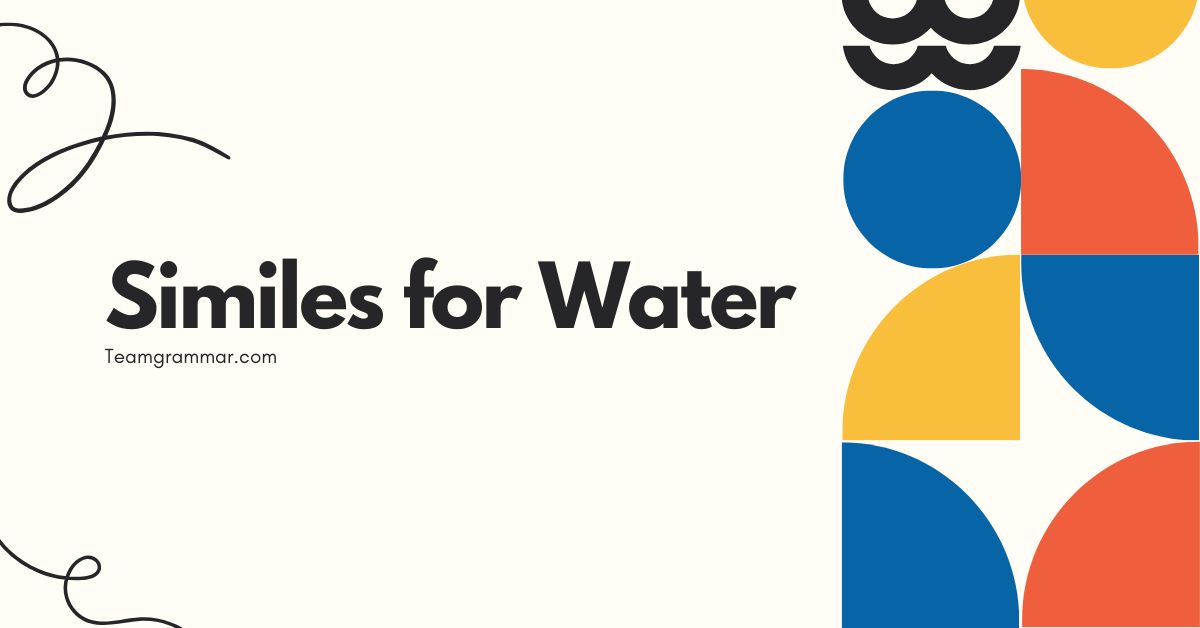39 Similes for Water: Enhancing Descriptive Language
Similes are powerful tools in the English language that allow us to create vivid and engaging descriptions by comparing one thing to another. Understanding how to effectively use similes, especially when describing something as ubiquitous and varied as water, is crucial for both creative writing and clear communication.
This article provides a comprehensive guide to using similes for water, exploring their structure, types, and usage, and offering numerous examples and practice exercises. Whether you’re a student, writer, or simply looking to improve your English skills, this guide will help you master the art of crafting compelling similes to describe water in all its forms.
By delving into the nuances of simile construction and exploring diverse applications, this article aims to equip you with the knowledge and skills necessary to elevate your descriptive writing. Mastering similes for water not only enhances your vocabulary but also sharpens your ability to observe and articulate the subtle qualities of this essential element.
Through clear explanations, practical examples, and engaging exercises, this guide will transform your understanding and usage of similes, making your writing more expressive and impactful. This article will benefit students, writers, ESL learners, and anyone who seeks to enhance their descriptive capabilities.
Table of Contents
- Introduction
- Definition of Similes
- Classification
- Function
- Contexts
- Structural Breakdown
- Types and Categories of Similes for Water
- Similes Describing Water’s Appearance
- Similes Describing Water’s Movement
- Similes Describing Water’s Sound
- Similes Describing Water’s Temperature
- Similes Describing Water’s Texture
- Similes Describing Water’s Emotional Impact
- Examples of Similes for Water
- Appearance Examples
- Movement Examples
- Sound Examples
- Temperature Examples
- Texture Examples
- Emotional Impact Examples
- Usage Rules for Similes
- Clarity and Relevance
- Originality and Creativity
- Cultural Sensitivity
- Common Mistakes with Similes
- Misused Words
- Cliches
- Inconsistent Comparison
- Practice Exercises
- Exercise 1: Identifying Similes
- Exercise 2: Completing Similes
- Exercise 3: Writing Similes
- Advanced Topics in Similes
- Extended Similes
- Simile vs. Metaphor
- Similes and Personification
- Frequently Asked Questions
- Conclusion
Definition of Similes
A simile is a figure of speech that directly compares two different things using the words “like” or “as.” It’s a tool used to make descriptions more vivid and relatable by drawing a connection between something familiar and something less known or understood. Similes are essential for adding depth and imagery to writing, allowing the reader to visualize and connect with the subject matter more effectively.
Classification
Similes are classified as a type of figurative language, specifically a comparison figure. They belong to a broader category that includes metaphors, analogies, and personifications.
What distinguishes similes is their explicit use of “like” or “as” to create the comparison, making the connection clear and direct.
Function
The primary function of a simile is to enhance understanding and create a more vivid image in the reader’s mind. By comparing water to something else, such as glass or a mirror, we can highlight its clarity and reflectiveness.
Similes also add emotional depth, making descriptions more impactful and memorable. They also serve to simplify complex ideas, making them more accessible to the audience.
Contexts
Similes are used across various contexts, from literature and poetry to everyday conversation and advertising. In literature, they create rich imagery and contribute to the overall tone and theme.
In advertising, they make products more appealing by associating them with positive qualities. In everyday speech, similes add color and expressiveness to communication.
The versatility of similes makes them a valuable tool in any form of communication.
Structural Breakdown
A simile typically consists of three main components: the subject (the thing being described), the linking word (“like” or “as”), and the object (the thing it’s being compared to). The structure is straightforward: Subject + Linking Word + Object.
Understanding this structure is key to creating effective and grammatically correct similes.
For example, in the simile “The water was as clear as glass,” the subject is “the water,” the linking word is “as,” and the object is “glass.” This simple structure allows for endless creative possibilities, as different subjects and objects can be combined to create new and interesting comparisons. The effectiveness of a simile depends on the relevance and clarity of the comparison.
Types and Categories of Similes for Water
Similes for water can be categorized based on the aspect of water being described. These categories include appearance, movement, sound, temperature, texture, and emotional impact.
Each category offers a different perspective on water, allowing for a wide range of descriptive possibilities.
Similes Describing Water’s Appearance
These similes focus on how water looks, whether it’s clear, murky, reflective, or colorful. They often compare water to objects known for their visual qualities, such as mirrors, diamonds, or ink.
These similes help the reader visualize the water’s appearance, creating a more vivid mental image.
Similes Describing Water’s Movement
These similes describe how water moves, whether it’s flowing, crashing, rippling, or still. They often use comparisons to animals, objects, or forces of nature known for their movement, such as snakes, dancers, or storms.
These similes capture the dynamic nature of water, adding energy and motion to the description.
Similes Describing Water’s Sound
These similes focus on the sounds water makes, whether it’s a gentle trickle, a loud roar, or a soft ripple. They compare water’s sounds to other sounds that are familiar and evocative, such as whispers, thunder, or music.
These similes engage the reader’s sense of hearing, making the description more immersive.
Similes Describing Water’s Temperature
These similes describe the temperature of water, whether it’s icy cold, lukewarm, or scalding hot. They often compare water to objects or sensations associated with temperature, such as ice, blood, or fire.
These similes evoke physical sensations, making the description more visceral and immediate.
Similes Describing Water’s Texture
These similes focus on how water feels, whether it’s smooth, rough, slippery, or sticky. They compare water to objects or materials known for their texture, such as silk, sandpaper, or glue.
These similes engage the reader’s sense of touch, adding another layer of sensory detail to the description.
Similes Describing Water’s Emotional Impact
These similes describe the emotional effect water has on people, whether it’s calming, invigorating, frightening, or nostalgic. They often compare water to emotions or experiences that evoke similar feelings, such as peace, excitement, fear, or memories.
These similes add emotional depth to the description, making it more meaningful and resonant.
Examples of Similes for Water
The following sections provide extensive examples of similes for water, organized by category. Each example is designed to illustrate the specific aspect of water being described, providing a wide range of options for enhancing your writing.
Appearance Examples
The following table showcases similes that describe the appearance of water. These examples highlight various aspects of water’s visual qualities, such as its clarity, color, and reflectivity.
Each simile uses “like” or “as” to draw a comparison between water and another object or concept, creating a vivid image in the reader’s mind.
| Simile | Explanation |
|---|---|
| The water was as clear as glass. | Highlights the water’s transparency and lack of impurities. |
| The lake was like a mirror, reflecting the sky. | Emphasizes the water’s ability to reflect images perfectly. |
| The river flowed like liquid silver in the moonlight. | Describes the shimmering, metallic appearance of the water. |
| The ocean was as blue as a sapphire. | Compares the water’s color to a precious gemstone. |
| The pond was like a murky puddle of ink. | Illustrates the water’s dark and unclear appearance. |
| The waterfall cascaded down like a curtain of diamonds. | Describes the sparkling, brilliant appearance of the falling water. |
| The water was as still as a painted canvas. | Emphasizes the water’s lack of movement and smooth surface. |
| The stream sparkled like scattered jewels. | Describes the water’s glittering and radiant appearance. |
| The ice was as clear as crystal. | Highlights the ice’s transparency and purity. |
| The water shimmered like heat haze on the asphalt. | Describes the distorted, wavy appearance of the water. |
| The sea was as green as emeralds. | Compares the water’s color to a vibrant green gemstone. |
| The water looked like a sheet of polished obsidian. | Illustrates the water’s dark, reflective, and glassy surface. |
| The waves were as white as freshly fallen snow. | Emphasizes the brightness and purity of the waves. |
| The lake was like a vast, shimmering coin. | Describes the water’s reflective surface and round shape. |
| The water was as dark as a moonless night. | Highlights the water’s deep, impenetrable darkness. |
| The river snaked through the valley like a ribbon of quicksilver. | Describes the river’s winding path and shimmering appearance. |
| The water was as smooth as polished glass. | Emphasizes the water’s sleek, flawless surface. |
| The pool glowed like a turquoise gem under the sunlight. | Describes the water’s vibrant color and radiant appearance. |
| The water resembled a sheet of crumpled tin foil. | Illustrates the water’s uneven, reflective surface. |
| The water was as clear as the air on a mountain top. | Highlights the water’s purity and transparency. |
| The water was like liquid light, dancing on the surface. | Describes the water’s shimmering and radiant appearance. |
| The water was as still as a photograph. | Emphasizes the water’s lack of movement and frozen appearance. |
| The water resembled a vast, undulating carpet of blue. | Illustrates the water’s expansive and wavy surface. |
| The water was as clear as a tear. | Highlights the water’s purity and transparency, evoking emotion. |
Movement Examples
The following table presents similes that describe the movement of water. These examples focus on how water flows, crashes, ripples, or remains still.
By comparing water’s movement to other dynamic entities, such as animals or natural phenomena, these similes bring action and energy to your descriptions.
| Simile | Explanation |
|---|---|
| The river flowed like a restless snake, winding through the valley. | Describes the river’s sinuous and continuous movement. |
| The waves crashed against the shore like thunderous applause. | Emphasizes the powerful and noisy impact of the waves. |
| The stream rippled like a dancer’s skirt in the breeze. | Illustrates the gentle and graceful movement of the water. |
| The waterfall cascaded down like a torrent of unleashed energy. | Describes the powerful and unstoppable flow of the water. |
| The water moved as slowly as molasses in winter. | Highlights the water’s sluggish and deliberate pace. |
| The waves surged forward like an army charging into battle. | Emphasizes the forceful and relentless advance of the waves. |
| The river flowed like a ribbon unwinding across the landscape. | Describes the smooth and continuous movement of the water. |
| The water swirled like a dizzying vortex, pulling everything in. | Illustrates the chaotic and disorienting movement of the water. |
| The stream trickled like a weeping child, soft and subdued. | Describes the gentle and delicate flow of the water. |
| The waves rolled in like liquid mountains, towering over the beach. | Emphasizes the immense size and power of the waves. |
| The water rushed past like a freight train, unstoppable and loud. | Highlights the speed and force of the water’s movement. |
| The pond shimmered like a living, breathing entity. | Illustrates the subtle and continuous movement of the water’s surface. |
| The floodwaters spread like a stain, consuming everything in their path. | Describes the destructive and pervasive nature of the flood. |
| The water danced like fireflies on a summer night. | Emphasizes the lively and erratic movement of the water. |
| The waves retreated like a defeated army, leaving debris behind. | Illustrates the receding movement of the waves after a crash. |
| The river pulsed like a vein, carrying life through the land. | Describes the vital and rhythmic movement of the water. |
| The ocean churned like a cauldron, brewing a storm. | Emphasizes the turbulent and chaotic movement of the water. |
| The stream meandered like a wandering soul, searching for its path. | Describes the aimless and gentle flow of the water. |
| The water evaporated like a ghost, disappearing into the air. | Illustrates the subtle and gradual transformation of the water. |
| The rapids roared like a pack of wild animals, untamed and fierce. | Emphasizes the powerful and aggressive movement of the water. |
| The water cascaded down the rocks like a silken curtain. | Describes the smooth and graceful flow of the waterfall. |
| The waves crashed against the cliffs like an angry mob. | Highlights the forceful and chaotic impact of the waves. |
| The river twisted and turned like a labyrinth, confusing and endless. | Illustrates the complex and winding path of the river. |
| The water ebbed and flowed like a heartbeat, steady and rhythmic. | Describes the regular and vital movement of the water. |
Sound Examples
The following table provides similes that describe the sound of water. These examples focus on the auditory qualities of water, such as its trickling, roaring, or splashing sounds.
By comparing water’s sounds to other familiar noises, these similes engage the reader’s sense of hearing, adding depth and immersion to your descriptions.
| Simile | Explanation |
|---|---|
| The stream gurgled like a contented baby. | Describes the soft and pleasant sound of the flowing water. |
| The waves roared like a thousand lions. | Emphasizes the loud and powerful sound of the ocean. |
| The rain pattered against the roof like tiny fingers tapping. | Illustrates the gentle and rhythmic sound of the rainfall. |
| The waterfall thundered like a drumroll, echoing through the valley. | Describes the loud and resonant sound of the cascading water. |
| The water lapped against the shore like a gentle whisper. | Highlights the soft and soothing sound of the waves. |
| The rapids hissed like angry snakes, warning of danger. | Emphasizes the sharp and menacing sound of the fast-flowing water. |
| The river chuckled as it flowed over the rocks. | Describes the light and cheerful sound of the water. |
| The fountain splashed like a joyous celebration. | Illustrates the lively and festive sound of the water. |
| The stream sighed as it meandered through the meadow. | Describes the soft and melancholic sound of the water. |
| The waves crashed like cymbals clashing in an orchestra. | Emphasizes the loud and dramatic sound of the ocean. |
| The dripping faucet echoed like a persistent drumbeat. | Highlights the repetitive and annoying sound of the water. |
| The waterfall murmured like a secret being shared. | Illustrates the quiet and intimate sound of the cascading water. |
| The rain whispered against the windowpane like a gentle lullaby. | Describes the soft and soothing sound of the rainfall. |
| The river roared like a defiant beast, challenging the mountains. | Emphasizes the powerful and aggressive sound of the water. |
| The waves sighed like a weary traveler, longing for rest. | Highlights the soft and melancholic sound of the ocean. |
| The stream babbled like a child, innocent and playful. | Illustrates the light and cheerful sound of the water. |
| The waterfall boomed like a cannon, shaking the ground below. | Describes the loud and explosive sound of the cascading water. |
| The rain drummed on the roof like a frantic message. | Emphasizes the intense and urgent sound of the rainfall. |
| The river hummed like a contented song, flowing through the land. | Highlights the pleasant and harmonious sound of the water. |
| The waves chanted like an ancient choir, resonating with history. | Illustrates the deep and rhythmic sound of the ocean. |
| The water trickled down the rocks like a tinkling melody. | Describes the delicate and musical sound of the water. |
| The waves pounded the shore like a blacksmith’s hammer. | Highlights the heavy and forceful sound of the ocean. |
| The stream whispered secrets to the trees as it passed. | Illustrates the soft and intimate sound of the water. |
| The waterfall crashed down like a symphony of sound. | Emphasizes the complex and harmonious sound of the cascading water. |
Temperature Examples
The following table features similes that describe the temperature of water. These examples focus on how cold, warm, or hot water feels.
By comparing water’s temperature to familiar sensations, these similes evoke physical feelings, making your descriptions more immediate and visceral.
| Simile | Explanation |
|---|---|
| The water was as cold as ice. | Highlights the extremely low temperature of the water. |
| The bathwater was like a warm embrace. | Emphasizes the comforting and soothing temperature of the water. |
| The water was as hot as molten lava. | Describes the dangerously high temperature of the water. |
| The pool felt like a refreshing chill on a summer day. | Illustrates the pleasantly cool temperature of the water. |
| The water was as lukewarm as a forgotten cup of tea. | Highlights the unpleasantly tepid temperature of the water. |
| The spring water tasted like liquid frost. | Emphasizes the icy coldness of the water. |
| The hot tub felt like a simmering cauldron. | Describes the intensely warm temperature of the water. |
| The water was as cool as a cucumber. | Illustrates the pleasantly refreshing temperature of the water. |
| The ocean was like a slap of icy needles on the skin. | Emphasizes the painfully cold temperature of the water. |
| The bath was as warm as a mother’s hug. | Describes the comforting and soothing temperature of the water. |
| The water burned like fire. | Highlights the scalding hot temperature of the water. |
| The stream felt like a refreshing kiss on a hot day. | Illustrates the pleasantly cool temperature of the water. |
| The water was as tepid as a stagnant pond. | Highlights the unpleasantly lukewarm temperature of the water. |
| The ice water felt like a shock to the system. | Emphasizes the extremely cold temperature of the water. |
| The hot springs were like a natural sauna. | Describes the intensely warm and therapeutic temperature of the water. |
| The water was as chill as a winter wind. | Illustrates the uncomfortably cold temperature of the water. |
| The icy water stung like a thousand bees. | Emphasizes the painfully cold temperature of the water. |
| The heated pool felt like a gentle caress. | Describes the pleasantly warm and soothing temperature of the water. |
| The water was as cold as a witch’s heart. | Highlights the extremely cold and uninviting temperature of the water. |
| The warm rain felt like a comforting shower. | Illustrates the pleasantly warm and soothing temperature of the water. |
| The glacial water was as crisp as a mountain breeze. | Describes the refreshingly cold temperature of the water. |
| The water was as frigid as the Arctic Ocean. | Highlights the extremely cold temperature of the water. |
| The hot tea felt like a soothing balm to my throat. | Emphasizes the comforting and warm temperature of the water. |
| The icy wind cut through me like a frozen blade. | Illustrates the painfully cold temperature of the water. |
Texture Examples
The following table presents similes that describe the texture of water. These examples focus on how smooth, rough, slippery, or sticky water feels.
By comparing water’s texture to familiar materials, these similes engage the reader’s sense of touch, adding another layer of sensory detail to your descriptions.
| Simile | Explanation |
|---|---|
| The water was as smooth as silk. | Highlights the soft and frictionless texture of the water. |
| The mud was like thick, sticky glue. | Emphasizes the viscous and adhesive texture of the mud. |
| The water was as rough as sandpaper. | Describes the abrasive and coarse texture of the water. |
| The mist felt like a soft, velvety curtain. | Illustrates the gentle and delicate texture of the water droplets. |
| The water was as slippery as an eel. | Highlights the difficult-to-grip texture of the water. |
| The foam was like a fluffy cloud. | Emphasizes the light and airy texture of the foam. |
| The water felt like tiny needles pricking the skin. | Describes the sharp and irritating texture of the water. |
| The dew was as delicate as spiderwebs. | Illustrates the fine and fragile texture of the dew. |
| The water was as heavy as lead. | Highlights the dense and substantial texture of the water. |
| The fog felt like a damp blanket. | Emphasizes the wet and enveloping texture of the fog. |
| The water was as crisp as fresh linen. | Describes the clean and refreshing texture of the water. |
| The mud was like a thick, gooey paste. | Illustrates the viscous and sticky texture of the mud. |
| The water felt like a thousand tiny kisses. | Emphasizes the gentle and soothing texture of the water. |
| The ice was as brittle as glass. | Highlights the easily breakable texture of the ice. |
| The water was as dense as cream. | Describes the thick and rich texture of the water. |
| The mist swirled like a soft, ethereal shroud. | Illustrates the gentle and enveloping texture of the water droplets. |
| The water felt like liquid velvet. | Emphasizes the smooth and luxurious texture of the water. |
| The mud was like a clinging embrace. | Describes the sticky and adhesive texture of the mud. |
| The water was as light as a feather. | Highlights the weightless and gentle texture of the water. |
| The rain felt like a thousand tiny taps on the skin. | Illustrates the gentle and rhythmic texture of the rainfall. |
Emotional Impact Examples
The following table provides similes that describe the emotional impact of water. These examples focus on how calming, invigorating, frightening, or nostalgic water can make people feel.
By comparing water to emotions or experiences, these similes add emotional depth to your descriptions, making them more meaningful and resonant.
| Simile | Explanation |
|---|---|
| The sound of the waves was like a lullaby, soothing my soul. | Emphasizes the calming and comforting effect of the ocean. |
| The cold water was like a jolt of electricity, invigorating my senses. | Highlights the energizing and refreshing effect of the water. |
| The storm was like a nightmare, filling me with dread. | Describes the frightening and overwhelming effect of the storm. |
| The river was like a memory, flowing gently through my mind. | Illustrates the nostalgic and reflective effect of the water. |
| The ocean was like a vast, unknowable mystery, inspiring awe. | Emphasizes the profound and awe-inspiring effect of the sea. |
| The rain was like tears from the sky, expressing sorrow. | Highlights the melancholic and mournful effect of the rainfall. |
| The waterfall was like a burst of joy, filling me with excitement. | Describes the exhilarating and uplifting effect of the cascading water. |
| The calm lake was like a moment of peace, offering tranquility. | Illustrates the serene and restful effect of the water. |
| The flood was like a destructive force, leaving devastation behind. | Emphasizes the terrifying and destructive effect of the flood. |
| The gentle stream was like a soft whisper, comforting my heart. | Highlights the soothing and reassuring effect of the water. |
| The sound of the rain was like a sad song, bringing memories back. | Illustrates the nostalgic and melancholic feeling evoked by rain. |
| The ocean’s vastness was like a mirror to my own solitude. | Emphasizes the feeling of isolation and introspection. |
| The rushing river was like a surge of adrenaline, filling me with energy. | Highlights the invigorating and exciting effect of the water. |
| The still lake was like a tranquil dream, offering escape. | Describes the peaceful and serene feeling of being near still water. |
| The crashing waves were like a furious battle, stirring fear within. | Emphasizes the frightening and overwhelming power of the ocean. |
| The gentle rain was like a soft caress, bringing comfort and peace. | Illustrates the soothing and calming effect of rain. |
| The vast ocean was like an endless possibility, inspiring hope. | Highlights the feeling of potential and opportunity. |
| The floodwaters were like a thief in the night, stealing peace of mind. | Describes the feeling of loss and vulnerability. |
| The babbling brook was like a cheerful friend, always there to listen. | Emphasizes the comforting and supportive feeling. |
| The crashing thunder was like a primal scream, awakening fear. | Illustrates the intense and frightening power of nature. |
Usage Rules for Similes
Using similes effectively requires attention to detail and an understanding of the rules that govern their proper use. These rules ensure that your similes are clear, relevant, and impactful, enhancing your writing rather than detracting from it.
Clarity and Relevance
A good simile should be clear and easily understood by the reader. The comparison should be relevant and make sense within the context of the writing.
Avoid obscure or confusing comparisons that may leave the reader puzzled. The purpose of a simile is to enhance understanding, not to create confusion.
For instance, “The water was as clear as mud” is not a good simile because it is contradictory. A better simile would be “The water was as clear as crystal”.
Originality and Creativity
While some similes are commonly used and widely understood, strive to create original and creative comparisons that will surprise and delight the reader. Avoid clichéd similes that have lost their impact through overuse.
A fresh and imaginative simile can make your writing stand out and leave a lasting impression.
Instead of saying “The water was as blue as the sky,” try something more unique like “The water was as blue as a kingfisher’s wing.”
Cultural Sensitivity
Be mindful of cultural differences and sensitivities when using similes. Some comparisons may be offensive or inappropriate in certain cultures.
Ensure that your similes are respectful and inclusive, avoiding stereotypes or generalizations that could be harmful. Consider your audience and the potential impact of your words.
For example, a simile that relies on a cultural reference that is not widely known may not be effective for a diverse audience.
Common Mistakes with Similes
Even experienced writers can make mistakes when using similes. Being aware of these common errors and how to avoid them can help you improve the quality of your writing and ensure that your similes are effective.
Misused Words
One common mistake is using the wrong linking word. Remember that similes use “like” or “as” to make a comparison.
Using other words, such as “than” or “resembles,” can create a comparison that is not a simile.
Incorrect: The water
Correct: The water is
Cliches
Overusing clichéd similes can make your writing seem uninspired and predictable. Cliches are phrases that have been used so often that they have lost their original impact.
Avoid common similes like “as clear as day” or “as smooth as silk” unless you have a specific reason to use them.
Cliché: The water was
Better: The water was
Inconsistent Comparison
Ensure that the comparison you are making is logical and consistent. Avoid comparing things that have little or no connection, as this can confuse the reader and weaken the impact of your simile.
The comparison should highlight a specific quality or characteristic that the two things share.
Inconsistent: The water was
Better: The water was
Practice Exercises
To solidify your understanding of similes for water, try the following exercises. These exercises will help you identify, complete, and write effective similes, improving your descriptive writing skills.
Exercise 1: Identifying Similes
Read the following sentences and identify the similes. Underline the simile in each sentence and explain what two things are being compared.
- The river flowed like a ribbon of silver in the moonlight.
- The waves crashed against the shore, creating a thunderous roar.
- The lake was as still as a mirror, reflecting the surrounding trees.
- The rain fell like tears from the sky, washing away the dust.
- The waterfall cascaded down the rocks, a curtain of shimmering light.
Answers:
- The river flowed like a ribbon of silver in the moonlight. (River and ribbon of silver)
- The lake was as still as a mirror, reflecting the surrounding trees. (Lake and mirror)
- The rain fell like tears from the sky, washing away the dust. (Rain and tears)
Exercise 2: Completing Similes
Complete the following similes by adding an appropriate comparison. Try to be creative and original in your responses.
- The water was as cold as __________.
- The waves crashed like __________.
- The stream flowed as gently as __________.
- The lake was as clear as __________.
- The water felt as smooth as __________.
Possible Answers:
- The water was as cold as ice in the Arctic.
- The waves crashed like a symphony of thunder.
- The stream flowed as gently as a mother’s caress.
- The lake was as clear as a pane of untouched glass.
- The water felt as smooth as liquid silk.
Exercise 3: Writing Similes
Write your own similes for water based on the following prompts. Focus on using vivid and descriptive language to create compelling comparisons.
- Describe the appearance of a murky pond.
- Describe the movement of a rushing river.
- Describe the sound of a gentle rain.
- Describe the temperature of icy water.
- Describe the texture of a thick fog.
Example Answers:
- The murky pond looked like a cauldron of dark secrets.
- The rushing river moved like a freight train hurtling down a track.
- The gentle rain sounded like a whispered conversation among the clouds.
- The icy water felt like a thousand needles pricking the skin.
- The thick fog felt like a damp shroud clinging to the earth.
Advanced Topics in Similes
Once you have mastered the basics of using similes, you can explore more advanced topics to further enhance your writing. These topics include extended similes, the difference between similes and metaphors, and the use of similes in conjunction with personification.
Extended Similes
An extended simile is a simile that is developed over several lines or sentences. Instead of a brief comparison, an extended simile explores the similarities between two things in greater detail, creating a more elaborate and impactful image.
Extended similes can add depth and complexity to your writing, allowing you to fully explore the nuances of the comparison.
Example:
The river was like a restless serpent, winding its way through the valley. It slithered past ancient rocks and gnarled trees, its scales shimmering in the sunlight.
Its journey was long and arduous, yet it persisted, driven by an unseen force, just as a serpent is driven by its primal instincts.
Simile vs. Metaphor
Similes and metaphors are both figures of speech that make comparisons, but they do so in different ways. A simile uses “like” or “as” to make an explicit comparison, while a metaphor implies a comparison without using these words.
Understanding the difference between similes and metaphors is essential for choosing the right figure of speech for your writing.
Simile: The water was as clear as glass.
Metaphor: The water was liquid glass.
In the simile, the water is being compared to glass, but it is not being identified as glass. In the metaphor, the water is being directly identified as liquid glass, creating a stronger and more direct comparison.
Similes and Personification
Personification is a figure of speech in which human qualities or characteristics are attributed to inanimate objects or abstract concepts. Similes can be used in conjunction with personification to create even more vivid and imaginative descriptions.
By combining these two figures of speech, you can bring the natural world to life and create a deeper connection with the reader.
Example:
The river chuckled like an old man as it flowed over the rocks, its waters whispering secrets to the trees that lined its banks.
In this example, the river is personified by being given the human qualities of chuckling and whispering. The simile “like an old man” further enhances the personification, creating a vivid and memorable image.
Frequently Asked Questions
Here are some frequently asked questions about using similes for water, along with their answers. These questions address common concerns and misconceptions about similes, providing further clarification and guidance.
What is the difference between a simile and an analogy?
A simile is a figure of speech that compares two unlike things using “like” or “as,” focusing on a shared quality or characteristic. An analogy, on the other hand, is a more extensive and complex comparison that explains the relationship between two things by highlighting their similarities and differences.
While a simile is a brief, direct comparison, an analogy is a more detailed and explanatory comparison.
How can I avoid using clichéd similes?
To avoid using clichéd similes, try to think beyond the obvious comparisons. Instead of relying on common phrases, brainstorm unique and imaginative ways to describe the subject.
Use sensory details and personal experiences to create fresh and original similes. Consider what makes the subject unique and try to capture that in your comparison.
Can a simile be too complex or obscure?
Yes, a simile can be too complex or obscure if it is difficult for the reader to understand. The purpose of a simile is to enhance understanding, so it should be clear and relevant.
Avoid using comparisons that are too abstract or that rely on specialized knowledge that the reader may not possess. If a simile requires too much explanation, it is likely too complex.
How do I choose the right linking word for a simile?
The choice between “like” and “as” depends on the structure of the sentence. Use “like” when comparing a noun or pronoun to another noun or pronoun.
Use “as” when comparing a clause or phrase to another clause or phrase. In general, “as” is used when the comparison involves a verb or action.
Example: The water was
Example: The water flowed
Is it okay to use multiple similes in a single piece of writing?
Yes, it is perfectly acceptable to use multiple similes in a single piece of writing, as long as they are used effectively and sparingly. Overusing similes can make your writing seem cluttered and distracting.
Use similes strategically to enhance your descriptions and add depth to your writing, but avoid overwhelming the reader with too many comparisons.
Conclusion
Mastering the art of crafting similes for water can significantly enhance your descriptive writing skills. By understanding the structure, types, and usage rules of similes, you can create vivid and engaging descriptions that bring the natural world to life.
Remember to focus on clarity, originality, and cultural sensitivity when using similes, and avoid common mistakes such as misused words and clichéd comparisons. With practice and attention to detail, you can elevate your writing and create a lasting impression on your readers.







